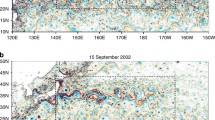Abstract
We consider air–sea interaction at the (atmospheric) synoptic and the mesoscale due to momentum transfer only. Two superposed one-layer fine-resolution shallow-water models are numerically integrated, where the upper layer represents the atmosphere and the lower layer the ocean. The frictional force between the two layers is implemented using a quadratic drag law and experiments with different values of the surface drag coefficient are performed. The actual energy loss of the atmosphere and the energy gain by the ocean, due to the interfacial shear, is determined and compared to estimates based on average speeds. The correlation between the vorticity in the atmosphere and the ocean is determined. Results differ from previous investigations where the exchange of momentum was considered at basin scale. It is shown that the ocean has a passive role, absorbing kinetic energy at nearly all times and locations, results showing that the energy input to the ocean increases almost quadratically with the value of the drag coefficient. Due to the feeble velocities in the ocean, the energy transfer depends only weakly on the oceanic velocity. The ocean dynamics leave nevertheless their imprint on atmospheric dynamics, leading to a quenched disordered state of the atmosphere–ocean system for the highest value of the drag coefficient considered. This finding questions the ergodic hypothesis for the idealized configuration studied here. The ergodic hypothesis is at the basis of a large number of experimental, observational and numerical results in ocean, atmosphere and climate dynamics.







Similar content being viewed by others
References
Berthier L, Biroli G (2011) Theoretical perspective on glass transition and amorphous materials. Rev Mod Phys 83:587–645. doi:10.1103/RevModPhys.83587
Charney J, Eliassen A (1964) On the growth of the hurricane depression. J Atmos Sci 21:68–75
Chelton DB, Schlax MG, Freilich MH, Milliff RF (2004) Satellite measurements reveal persistent small-scale features in ocean winds. Science 303:978–983
Chen D, Jirka GH (1997) Absolute and convective instabilities of plane turbulent wakes in a shallow water layer. J Fluid Mech 338:157–172 doi:10.1017/S0022112097005041
Courant R, Friedrichs K, Lewy H (1928) Uber die partiellen Differenzengleichungen der mathematischen Physik. Math Ann 100:32–74. doi:10.1007/BF01448839 (in German)
Duhaut HA, Straub N (2006) Wind stress dependence on ocean surface velocity: implication for mechanical energy input to ocean circulation. J Phys Oceanogr 36:202–211
Esau I (2014) Indirect air-sea interactions simulated with a coupled turbulence-resolving model. Ocean Dyn 64:689–705
Ferrari R, Wunsch C (2009) Ocean circulation kinetic energy: reservoirs, sources, and sinks. Annu Rev Fluid Mech 41:253–282. doi:10.1146/annurev.fluid.40.111406.102139
Hogg AM, Dewar WK, Berloff P, Kravtsov S, Hutchinson DK (2009) The effects of mesoscale ocean–atmosphere coupling on the large-scale ocean circulation. J Clim 22:4066–4082. doi:10.1175/2009JCLI2629.1
Moulin A, Wirth A (2014) A drag-induced barotropic instability in air-sea interaction. J Phys Oceanogr 44:733–741
Roquet F, Wunsch C, Madec G (2011) On the patterns of wind-power input to the ocean circulation. J Phys Oceanogr 41:2328–2342. doi:10.1175/JPO-D-11-024.1
Seo H, Murtugudde R, Jochum M, Miller AJ (2008) Modeling of mesoscale coupled ocean-atmosphere interaction and its feedback to ocean in the Western Arabian Sea. Ocean Model 25:120–131. doi:10.1016/j.ocemod.2008.07.003
Shepherd TG (1987) Non-ergodicity of inviscid two-dimensional flow on a beta-plane and on the surface of a rotating sphere. J Fluid Mech 184:289–302
Stillinger FK, Debenedetti PG (2013) Glass transition thermodynamics and kinetics. Annu Rev Condens Matter Phys 4:263–285. doi:10.1146/annurev-conmatphys-030212-184329
Stull RB (1988) An introduction to boundary layer meteorology. Kluwer Academic Publishers, Dordrecht, 666 pp
Vallis GK (2006) Atmospheric and oceanic fluid dynamics. Cambridge University Press, U.K. 745 pp
Acknowledgments
We thank J.B. Flór for discussion. The work is funded by AGIR, UGA (France) and by a grant from Labex OSUG@2020 (Investissements d’avenir – ANR10 LABX56). Calculations were done at IDRIS (France) project: i2015016802.
Author information
Authors and Affiliations
Corresponding author
Rights and permissions
About this article
Cite this article
Moulin, A., Wirth, A. Momentum Transfer Between an Atmospheric and an Oceanic Layer at the Synoptic and the Mesoscale: An Idealized Numerical Study. Boundary-Layer Meteorol 160, 551–568 (2016). https://doi.org/10.1007/s10546-016-0153-x
Received:
Accepted:
Published:
Issue Date:
DOI: https://doi.org/10.1007/s10546-016-0153-x




